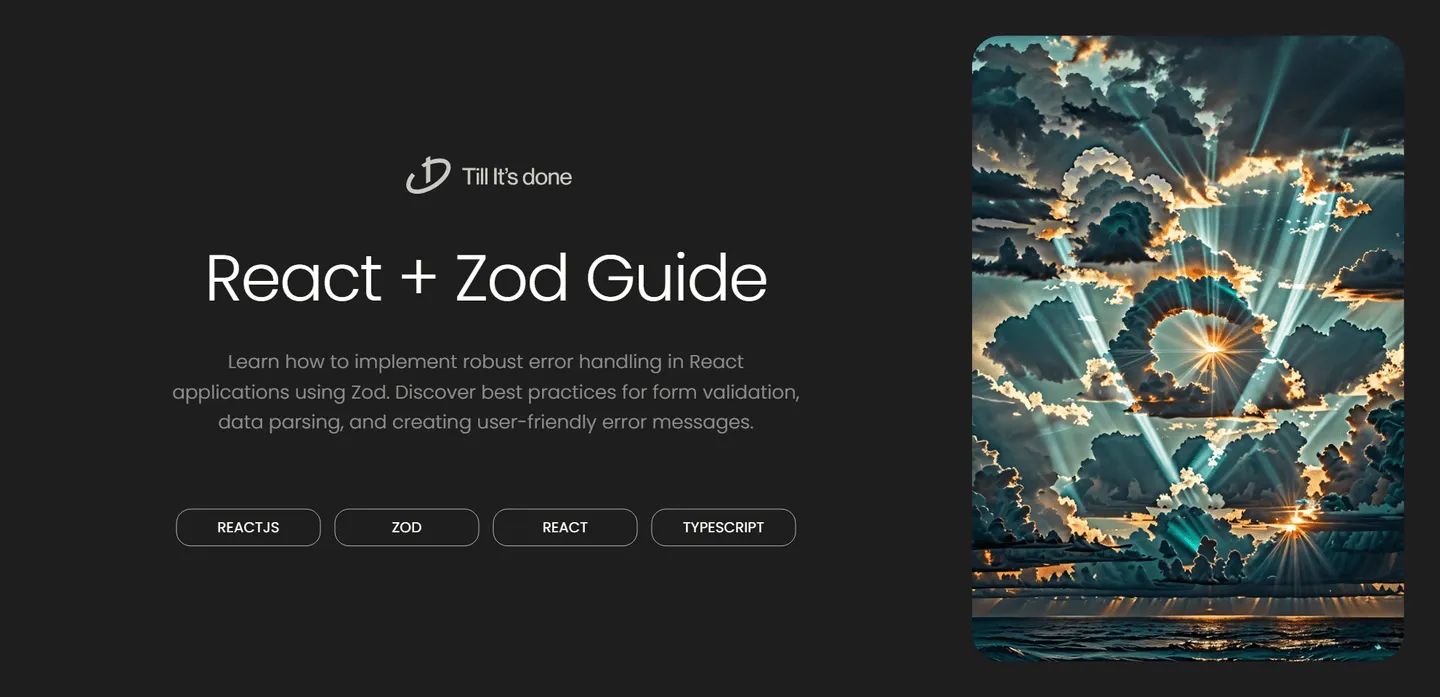- Services
- Case Studies
- Technologies
- NextJs development
- Flutter development
- NodeJs development
- ReactJs development
- About
- Contact
- Tools
- Blogs
- FAQ
Error Handling in React Applications with Zod
Discover best practices for form validation, data parsing, and creating user-friendly error messages.


Error handling is one of those aspects of application development that often gets overlooked until things start breaking in production. As React applications grow in complexity, proper form validation and data parsing become crucial for maintaining a robust user experience. Enter Zod – a TypeScript-first schema validation library that makes error handling both powerful and developer-friendly.
Understanding Zod’s Role in React Applications
Think of Zod as your application’s security guard, checking every piece of data that enters your system. Whether it’s form inputs, API responses, or configuration objects, Zod ensures that your data matches exactly what you expect.
Let’s dive into a real-world example that many developers face: handling user registration forms.
import { z } from "zod";import { useState } from "react";
const userSchema = z.object({ email: z.string().email("Invalid email format"), password: z .string() .min(8, "Password must be at least 8 characters") .regex(/[A-Z]/, "Password must contain at least one uppercase letter"), confirmPassword: z.string()}).refine((data) => data.password === data.confirmPassword, { message: "Passwords don't match", path: ["confirmPassword"]});
Implementing Error Boundaries with Zod
One of the most powerful features of Zod is its ability to provide detailed error messages when validation fails. Here’s how we can create a robust error handling system:
const RegistrationForm = () => { const [errors, setErrors] = useState<z.ZodError | null>(null);
const handleSubmit = (formData: unknown) => { try { const validatedData = userSchema.parse(formData); // Proceed with registration } catch (error) { if (error instanceof z.ZodError) { setErrors(error); } } }; // ... rest of the component}The beauty of this approach is that Zod doesn’t just tell you something is wrong – it tells you exactly what’s wrong and where the problem is.
Advanced Error Handling Patterns
Sometimes we need to handle more complex scenarios, like nested objects or arrays. Zod makes this surprisingly straightforward:
const addressSchema = z.object({ street: z.string(), city: z.string(), country: z.string()});
const userProfileSchema = userSchema.extend({ addresses: z.array(addressSchema) .min(1, "At least one address is required")});
Best Practices and Tips
- Always define your schemas outside of components for better reusability
- Use transform methods to sanitize data before validation
- Implement custom error messages for better user experience
- Consider using Zod with React Hook Form for seamless form handling
Remember, good error handling isn’t just about catching errors – it’s about providing clear feedback that helps users understand and resolve issues quickly.
Conclusion
Integrating Zod into your React application might seem like extra work initially, but the peace of mind and robust error handling it provides are invaluable. By catching and handling errors effectively, we create applications that aren’t just functional, but truly professional and user-friendly.

 สร้างเว็บไซต์ 1 เว็บ ต้องใช้งบเท่าไหร่? เจาะลึกทุกองค์ประกอบ website development cost อยากสร้างเว็บไซต์แต่ไม่มั่นใจในเรื่องของงบประมาณ อ่านสรุปเจาะลึกตั้งแต่ดีไซน์, ฟังก์ชัน และการดูแล พร้อมตัวอย่างงบจริงจาก Till it’s done ที่แผนชัด งบไม่บานปลายแน่นอน
สร้างเว็บไซต์ 1 เว็บ ต้องใช้งบเท่าไหร่? เจาะลึกทุกองค์ประกอบ website development cost อยากสร้างเว็บไซต์แต่ไม่มั่นใจในเรื่องของงบประมาณ อ่านสรุปเจาะลึกตั้งแต่ดีไซน์, ฟังก์ชัน และการดูแล พร้อมตัวอย่างงบจริงจาก Till it’s done ที่แผนชัด งบไม่บานปลายแน่นอน  Next.js สอน 14 ขั้นตอนเบื้องต้น: สร้างโปรเจกต์แรกใน 30 นาที เริ่มต้นกับ Next.js ใน 14 ขั้นตอนเพียงแค่ 30 นาที พร้อม SSR/SSG และ API Routes ด้วยตัวอย่างโค้ดง่าย ๆ อ่านต่อเพื่อสร้างโปรเจ็กต์แรกได้ทันทีที่นี่
Next.js สอน 14 ขั้นตอนเบื้องต้น: สร้างโปรเจกต์แรกใน 30 นาที เริ่มต้นกับ Next.js ใน 14 ขั้นตอนเพียงแค่ 30 นาที พร้อม SSR/SSG และ API Routes ด้วยตัวอย่างโค้ดง่าย ๆ อ่านต่อเพื่อสร้างโปรเจ็กต์แรกได้ทันทีที่นี่  วิธีสมัคร Apple Developer Account เพื่อนำแอปขึ้น App Store ทีละขั้นตอน อยากปล่อยแอปบน App Store ระดับโลก มาอ่านคู่มือสมัคร Apple Developer Account พร้อมเคล็ดลับ TestFlight และวิธีอัปโหลดที่ง่ายในบทความเดียวนี้ได้เลย
วิธีสมัคร Apple Developer Account เพื่อนำแอปขึ้น App Store ทีละขั้นตอน อยากปล่อยแอปบน App Store ระดับโลก มาอ่านคู่มือสมัคร Apple Developer Account พร้อมเคล็ดลับ TestFlight และวิธีอัปโหลดที่ง่ายในบทความเดียวนี้ได้เลย  TypeScript Interface คืออะไร? อธิบายพร้อมวิธีใช้และข้อแตกต่างจาก Type เรียนรู้วิธีใช้ TypeScript Interface เพื่อสร้างโครงสร้างข้อมูลที่ปลอดภัยและเข้าใจง่าย พร้อมเปรียบเทียบข้อดีข้อแตกต่างกับ Type ที่คุณต้องรู้ ถูกรวมเอาไว้ในบทความนี้แล้ว
TypeScript Interface คืออะไร? อธิบายพร้อมวิธีใช้และข้อแตกต่างจาก Type เรียนรู้วิธีใช้ TypeScript Interface เพื่อสร้างโครงสร้างข้อมูลที่ปลอดภัยและเข้าใจง่าย พร้อมเปรียบเทียบข้อดีข้อแตกต่างกับ Type ที่คุณต้องรู้ ถูกรวมเอาไว้ในบทความนี้แล้ว  Material-UI (MUI) คืออะไร อยากสร้าง UI สวยงามและเป็นมืออาชีพในเวลาอันรวดเร็วใช่ไหม มาทำความรู้จักกับ Material-UI (MUI) ที่ช่วยให้คุณพัฒนาแอปพลิเคชันบน React ได้ง่ายและดูดีในทุกอุปกรณ์
Material-UI (MUI) คืออะไร อยากสร้าง UI สวยงามและเป็นมืออาชีพในเวลาอันรวดเร็วใช่ไหม มาทำความรู้จักกับ Material-UI (MUI) ที่ช่วยให้คุณพัฒนาแอปพลิเคชันบน React ได้ง่ายและดูดีในทุกอุปกรณ์  เปรียบเทียบ 3 วิธีติดตั้ง install node js บน Ubuntu: NVM vs NodeSource vs Official Repo แบบไหนดีที่สุด? เรียนรู้วิธีติดตั้ง Node.js บน Ubuntu ด้วย NVM, NodeSource หรือ Official Repo เลือกวิธีที่เหมาะกับความต้องการของคุณ พร้อมเปรียบเทียบ เพื่อการพัฒนาที่มีประสิทธิภาพ!
เปรียบเทียบ 3 วิธีติดตั้ง install node js บน Ubuntu: NVM vs NodeSource vs Official Repo แบบไหนดีที่สุด? เรียนรู้วิธีติดตั้ง Node.js บน Ubuntu ด้วย NVM, NodeSource หรือ Official Repo เลือกวิธีที่เหมาะกับความต้องการของคุณ พร้อมเปรียบเทียบ เพื่อการพัฒนาที่มีประสิทธิภาพ! Talk with CEO
We'll be right here with you every step of the way.
We'll be here, prepared to commence this promising collaboration.
Whether you're curious about features, warranties, or shopping policies, we provide comprehensive answers to assist you.


